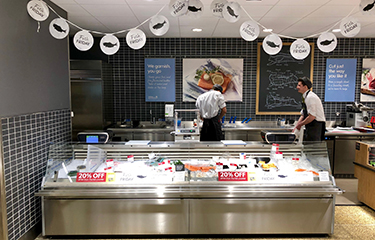Recognizing Britons’ continuing concerns about inflation, U.K. grocers are slashing prices on staple seafood products.
Rising inflation continued to impact U.K. seafood sales in December, which dropped despite being typically higher for the Christmas holiday. The overall chilled fish category in the U.K. realized a 1.3 percent drop in sales in the quarter ending in December 2022 compared to the same quarter in 2021, according to data provided to SeafoodSource by research firm Kantar. Chilled fish prices soared by 7.7 percent in December, after rising 5.2 percent in November, according to Kantar.
Hit worse was the smoked fish sub-category, which experienced a sales drop of 8.1 percent, driven by a steep decline in shopper numbers and frequency, according to Kantar.
Natural fish sales soared 6 percent during the quarter, even though sales volumes dropped 4.3 percent, as prices increased by 10.7 percent. Overall U.K. grocery sales rose 9.4 percent in December, reaching a record for the month at GBP 12.8 billion (US 15.4 billion, EUR 14.5 billion), according to Kantar.
“Value sales are up significantly, but grocery price inflation is the real driving factor behind this, rather than increased purchasing,” Kantar Head of Retail and Consumer Insights Fraser McKevitt said. “If we look at the amount people bought this period, sales measured by volume are actually down by 1 percent year-on-year, showing the challenges shoppers are facing.”
A growing problem through 2022, U.K. grocery price inflation was 14.4 percent in December, a slight decline from 14.6 percent in November, McKevitt said.
“This is the second month in a row that grocery price inflation has fallen, raising hopes that the worst has now passed,” McKevitt said. “However, it’s still a painfully high figure at the current rate, impacting how and what we buy at the shops.”
To help shoppers concurred about grocery inflation, Morrisons is cutting prices for 130 of its Savers Range products, including frozen fish fingers and prawns, along with tinned tuna chunks.
“Morrisons has invested over GBP 16 million [USD 19 million, EUR 18 million] to make these cuts, as customers look for help on their weekly shop after the expense of Christmas and as the cost of living crisis continues to impact household grocery budgets,” the company said in a press release.
Responding to the inflation crisis, Tesco has announced price locks on more than 1,000 grocery items through Easter,, including Tesco Breaded Plaice Fillets. Tesco enacted a similar price lock from October through the start of January.
“As we start the New Year, we know times are tough for many of our customers right now. We hope this extended price lock commitment gives our customers the certainty of knowing that over a thousand household favorites and own brand essentials will stay at the same low price for months to come – helping them budget when they need it most,” Tesco U.K. Chief Executive Jason Tarry said in a press release.
Kantar warned that seafood inflation could cause shoppers to trade down from the category to poultry and meat products.
“It is possible that shoppers are trading down from seafood to chicken and pork, which are “overperforming in terms of volume, declining only 0.1 percent and 1 percent respectively, despite the fact that chicken has experienced the largest price increases of all proteins – up 17 percent during the quarter,” Kantar said, referring to the quarter ending 30 October.
Chilled fish prices rose 4.8 percent during that quarter – lower than price increases in fresh meat and poultry, which both spiked 9.8 percent, according to Kantar.
“Price rises of 4.8 percent [for chilled fish] are lower than many alternatives, but high baseline prices means it is still vulnerable to downtrading,” Kantar said in its Meat, Fish, and Poultry monthly report. “Chilled fish volume losses of 8.2 percent are too much to be offset by price increases, and consequently, the category is in overall decline.”
Similar to the quarter ending in December, smoked fish realized the biggest sales decline for the quarter ending in October, dropping 12 percent, followed by battered fish, which decreased 8.4 percent.
“The underperformance of [the] battered [segment] suggest the interaction between chilled and frozen fish will be important to watch through the winter,” Kantar said. “Coated fish is more prominent in the freezer aisle, and therefore, its chilled equivalent could be vulnerable to losses to frozen.”
Natural fish is the only sub-sector within chilled fish that realized an increase in sales during the October quarter, growing 1.1 percent during the quarter even though it is one of the most-expensive proteins, Kantar noted.
"This shows that shoppers are willing to pay more if they feel there is a justification,” it said.
Photo courtesy of photocritical/Shutterstock







